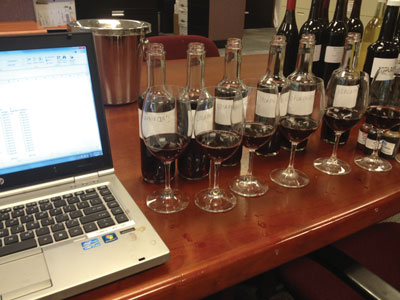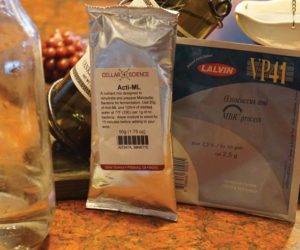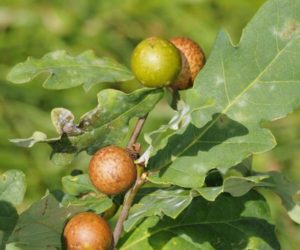
Q
I am planning to try a new product on some older cabernet wine (2015 vintage) that has not yet been bottled. It has a harshness that might be related to tannins. It starts out okay for the mouthfeel, but the finish is harsh on the tip of the tongue.
My question is with the use of gum arabic where I’m using a liquid product called Maxigum. The supplier provided recommendations for the dosage — approximately 1 mL per liter. The suggestion was to add this prior to bottling but nothing about how long it takes to be effective. I tried some small samples with it and there wasn’t much of a change right after. The other issue is integrating this rather viscous solution into the wine in a 6-gallon (23-L) carboy. It would seem that this additive would have to be thoroughly stirred. I would appreciate your thoughts on this product.
G. Weiler
North Vancouver, British Columbia
A
Before I launch into my information about gum arabic and related products, do take a minute to think that gum arabic may not give you the result you’re looking for. Gum arabic can smooth out the perception of tannins in some wines, but I’ve found that sometimes it can make the problem seem worse. If gum arabic doesn’t solve your problem, you may want to consider protein fining, which will remove tannins, not just mask them. Proteins have been used in winemaking since time immemorial. Egg whites, milk, animal gelatin, and yes, even the infamous bull’s blood, have been used in winemaking for centuries (though no one uses blood anymore as far as I know). The protein molecules adhere to excess tannin in the wines and then fall to the bottom of the container as sediment, essentially sweeping the tannins from the wine. The wine is then racked off the sediment and hey presto, the resulting wine is clarified and carries less of a tannin burden. When done right, the wine is softer, rounder and more approachable. I find that gum arabic, indeed, can smooth out red wines, but as you’ll see below, it’s sometimes not the best, or only, solution.
I was first introduced to the range of gum arabic products available for winemaking at Bonny Doon Vineyard when “rebel winemaker” (he’s a bit of an iconoclast) Randall Grahm brought it back from one of his trips to France, around 1999 or so. We did a lot of experimentation work with it at the winery (I was the Enologist, and later the Assistant Winemaker) and sometimes we ended up adding it to reds, whites, or pink wines. The general effect it gave was a slight softening of tannins, an increase in apparent viscosity, and a sense of sweetness without any residual sugar.
Gum arabic was first introduced in the wine industry in Europe about 75–80 years ago to improve tartrate stability, back when traditional cold stability was difficult to achieve (not to mention expensive) with chilling the wine to near freezing temperatures. Gum arabic, also known as gum acacia or Arabinol (the brand you mention is Maxigum, a product sold by Enartis USA), is a natural carbohydrate polymer that comes from the sap of two species of African Acacia trees: A. senegal and A. seyal. It’s safe and natural and has been used for centuries in foods, jams, candies, drinks, and cough medicines. Gum arabic is a legal wine additive that a home winemaker can also use to enhance mouthfeel, to smooth out tannins, and to lengthen the finish of wines.
Gum arabic is a legal wine additive that a home winemaker can also use to enhance mouthfeel, to smooth out tannins and to lengthen the finish of wines.
Gum arabic products are usually sold in liquid form and, in addition to preventing tartrate instability, can lessen the perception of astringent and bitter tannins. Because Arabinol contains large polysaccharide molecules, it is quite thick and is often perceived as “sweet” on the palate even though it’s technically not a fermentable sugar. As you allude to, it’s very important to mix it in well to your containers or carboys because it is so viscous. It can be added to wine right before bottling but I prefer to add it about 1–2 weeks before bottling, after the final blend is assembled and any other major treatments have been done.
Gum arabic isn’t always the answer for every wine. In some cases, gum arabic products might improve mouthfeel, in some cases not. I find it is not a uniform quality-enhancer and, unlike other adjustments (tartaric acid, for instance), is not linear, i.e. adding more doesn’t always get you “more” effect. It’s important to find the sweet spot with each wine individually.
The dosage that Enartis recommends for Maxigum is 0.2–1.0 mL/L (200–1000 uL/L), though I tend to find the “sweet spot” lies between 0.5–0.75 mL/L (500–750 uL/L). To do bench trials with small samples of wine and such small doses, you’ll probably want to invest in a set of Eppendorf pipettes in the 0-100 uL and 100-1,000 uL range. They can cost hundreds of dollars so may seem like a huge investment, but if you are a serious small-scale winemaker, Eppendorfs, along with a scale that can measure tenths of a gram will serve you well over many years of winemaking.
If I were to do Maxigum trials, here is what my bench trial would look like. First I’d measure out 50 mL aliquots of my wine to treat in individual, identical wine glasses. As you don’t have a lot of wine to waste on trials, using 50 mL samples is probably ideal for most micro-vintners. Next I would use my Eppendorf pipette to measure out the Maxigum in my 0.5 mL/L–0.75 mL/L (500–750 uL/L) dosage range. To walk you and fellow readers through a conversion of units (skip if you’ve done this a million times before): 500 uL/L = 25 uL/50 mL; and 750 uL/L= ~ 37 ul/50 ml. So let’s say you try three glasses at first: Control (0 uL/50 mL), the 0.50 mL/L range (25 uL/50 mL), and the 0.75 mL/L range (37 uL/50 mL).
Measure in the Maxigum directly into your two glasses with your micropipette, swirl all three, seal all three glasses (we use a watch glass, which is a small concave glass disk that fits over the mouth of the wine glass), let rest and react for about 15 minutes and then uncover the glasses, taste, and evaluate all three samples. Gum arabic doesn’t take very long to interact with that small dose of wine and can be assessed almost immediately. The color will be unchanged but smell for any aromatic differences. Then sip, swish in your mouth and spit (or swallow, if you don’t have anything else you’re doing that day) and see if there were any effects. Were they positive or negative? How about in the attack, mouthfeel, taste, astringency or length of finish? Did either addition get you a more positive result than the control? If so, which did you like best? Did you like any of them? Having more than one taster can be helpful . . . most of the time.
The above approach is one that I recommend with just about any fining agent or additive. Start with the manufacturer’s recommended dosage range, temper it with your own experience, then calculate out what kind of uL (microliter) or gram range you’ll need in order to evaluate a 50 mL bench trial. Some people like to use 100 mLs because it’s easier to calculate, but I find that if you’re doing a lot of trials, it’ll use up a lot of your very valuable wine.
If Maxigum doesn’t give you the result you’re looking for, try protein fining. The easiest, cheapest thing for home winemakers to use would be egg whites. I have a full description of egg white fining in The Winemaker’s Answer Book, and winemakermag.com can be searched for past articles which have covered the topic. Egg whites tend to be among the mildest of protein finings, making them a good place to start . . . and available at the supermarket! Enartis, and other industry suppliers like Scott Labs, Laffort, and AEB (hey, I must be an equal opportunity Wine Wizard here) all sell protein fining agents in liquid and powder form. Laffort, interestingly, has a new vegetable-sourced (peas!) protein available if you’re worried about an egg allergy and don’t want to use any animal-based fining agents. It might surprise you to know that, for all our talk about it, most winemakers don’t use protein-based fining agents on their wines. It’s expensive, fiddly to do, and picking the grapes at optimum ripeness, proper vinification and time are often all the “fining agents” we need.
Egg whites tend to be among the mildest of protein finings,
making them a good place to start . .
If you decide to take the fining agent route, you’ll have to do bench trials here as well in order to find out which additive gives you the effect you like. For protein fining trials you’re going to need to leave time for your trial to settle (at least 72 hours), so I find working with little 200–187 mL screw-top bottles allow me to conserve valuable wine but also get good settling. Most home winemaking supply stores carry small-capped containers like these. After you measure in your fining agent dose with your micropipettes (it’ll be very small, trust me!), let settle at least 24 hours, then decant off the sediment into your tasting glass. For this reason I like the little Bordeaux-shaped 187-mL bottles because they’re tall, narrow, and give decent lees compaction; much more so than a larger-diameter bottle. Since you have an aged-red wine, it’s likely you’ll only need a very little bit of a protein fining agent to achieve the result you’re seeking.
Q
I’ve been growing my own grapes for 5 years but have been making wines for over 10 years. I’ve made some really good reds over the years but no matter what I do I always end up with some sediment in the bottles. I’ve tried fining with egg whites, bentonite, and isinglass. I’ve tried fine filtering with my Buon Vino Super Jet. And I always do 7+ rackings over the course of 14 months. I wait at least a couple months after the last racking to make sure there’s no sediment on the bottom of the carboy before bottling. But no matter how clean the wine in the carboy was some sediment always precipitates after I bottle it. It doesn’t impact the flavor and is only noticeable when the last glass is poured but I don’t feel proud giving it to friends. What do I need to do to prevent this from happening?
Wil Malski
Grand Haven, Michigan
A
Goodness, you’ve got a persistent sediment source in your wines that’s for sure. You’ve removed the gross particles by racking and filtration.You’ve cleared out proteins by using bentonite. You’ve taken out excess tannins with proteins like egg whites and isinglass. Also you’ve provided plenty of time for settling before bottling and have sterile-filtered right before bottling, excluding any spoilage microbes which might start some kind of post-bottling fermentation and sedimentation. What this tells me is that the source of your sediment(s) is/are smaller than the 0.45-micron size of a bacteria cell, and that it’s something happening on the molecular level in your wine.
Let me run through some things that might help, depending on what is causing your post-bottling instability:
-Don’t make any last-minute blends: I’m guessing your sediment is coming from unstable color compounds, potassium bitartrate crystals, or a mix of the two. Both are small enough to pass through a sterile filter and affect your wine down the road. Are you making blends right before bottling? Even if you have two different batches of racked, fined, and filtered wine, if you mix them together right before bottling their components could create an unstable wine which could throw a sediment in the bottle later. By getting the blend together as early as is practical, you allow time for those reactions to occur and you’ve got plenty of time to correct for, and rack the wine off, any instabilities. Last-minute blends risks unforeseen consequences, one of which can certainly be unstable pigments and potassium tartrate instabilities.
-Don’t make any last-minute macro-chemistry changes: Like last-minute blending, making any big swings like acid-adjustment or blending a low-alcohol with a high-alcohol wine are both a recipe for instabilities. Be sure you’re doing most of your big adjustments and changes months before bottling.
-Chill to force tartrate stabilization: While red wines aren’t normally cold stabilized (chilled to 35 °F/2 °C for a few weeks and seeded with potassium bitartrate crystals, then racked off the sediment), excess potassium bitartrate in your wine can still cause a big mess in the bottle. By putting your wine through a cold-storage regimen, it’s possible that the formation of crystals would be forced, resulting in fewer crystals and less sediment down the road. Do you have a wine or beer fridge? Can you store your carboys outside during the winter for few weeks? I’ll bet in Michigan you probably have a garden shed, garage overhang, or space under your porch where you could store your carboys for a few weeks, if there were a period in the fall, winter, or spring where the temperatures fluctuated between 35–45 °F (2–7 °C). You don’t want it so cold that your wine will freeze and burst the carboys, and you don’t want it to be warm, so your wine is cooking out of doors. A fridge at a constant temperature is best, but a couple of weeks at 30–50 °F (-1–10 °C) outside would help to force the formation of bitartrate sediment now, rather than after you filter and bottle. Of course, shield the wine from sunlight to avoid a light-struck flaw if you move it outdoors.
-Try a gum arabic product to retard crystal formation and color precipitation: Funny that you should write with your sediment problems in the same issue that our friend, G. Weiler (question on page 16) mentions that they’d like to try a gum arabic product to help with excess tannins. Even though you’re not dealing with a sensory issue (tannic wine), gum arabic and related arabinol products were also developed to help with cold stability. Their high molecular weight and highly branched carbohydrate polysaccharide structure hamper the precipitation of both colored material and bitartrate crystals in bottle-ready wine.
It’s important to do bench trials to see the effect on the wine with any addition. Because you’d be adding gum arabic for stability reasons and not to enhance mouthfeel or mask tannins, I’d recommend the medium to higher dose rate, or 0.5–1 mL/L. As I describe earlier, measure out some 50 mL aliquots of your wine, dose in the 0.5–1 mL/L range, and see what the effects are. If the 1 mL/L rate doesn’t deliver any negative sensory effects, I’d be tempted to go with the higher rate. Read each manufacturer’s directions but in general, gum arabic adds are made after final filtration and before bottling. I like to wait at least 72 hours between addition and bottling. Good luck!
Do you have a winemaking or wine-related question for the Wine Wizard? Please email us at [email protected] and your question may appear in an upcoming issue.






